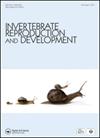Population features, sexual dimorphism and handedness of the primary freshwater crab Trichodactylus cf. fluviatilis (Brachyura: Trichodactylidae) from southeastern Brazil
IF 0.8
4区 生物学
Q4 REPRODUCTIVE BIOLOGY
引用次数: 2
Abstract
ABSTRACT Recent molecular analyses characterized the freshwater crab Trichodactylus fluviatilis as a species complex. Considering this new scenario, studies about the population features are fundamental to understanding the biology of species belongs to this complex. We investigated the population from southeastern Brazil identify as Trichodactylus cf. fluviatilis, testing the hypotheses that sex ratio differs from the expected 1:1, and that the species shows sexual dimorphism in size, weaponry and body weight. The reproductive period and handedness were also investigated. Population features were determined based on the size-frequency distribution, gonadal development and sex ratio. Sexual dimorphism was analysed comparing the average size and the allometric coefficient. Handedness was verified according to the proportion of right and left chelipeds. Sex ratio skewed towards males and the reproduction was continuous. The sexual dimorphism in T. cf. fluviatilis was found in structures related to weaponry and reproduction. In weaponry, sexual dimorphism was demonstrated by robust chelipeds and high allometric values in males. In females, a high allometric was recorded to the abdomen, structure directly related to reproduction. The right-handedness was observed to the species. All these results contribute to a better understanding of the species’ life history.巴西东南部淡水毛趾蟹(短足目:毛趾蟹科)的种群特征、性别二态性和手性
摘要近年来的分子分析表明,河蟹是一种复杂的物种。考虑到这种新的情况,对种群特征的研究对于理解属于这种复合体的物种的生物学是至关重要的。我们调查了来自巴西东南部的一个种群,该种群被鉴定为Trichodactylus cf.fluviatilis,检验了性别比与预期的1:1不同的假设,以及该物种在大小、武器和体重方面表现出两性异形的假设。生殖期和利手性也进行了调查。根据大小频率分布、性腺发育和性别比确定种群特征。对两性异形进行了分析,比较了平均大小和异速系数。根据左螯和右螯的比例来验证手性。性别比例向男性倾斜,生殖是连续的。在与武器和繁殖有关的结构中发现了河纹T.cf.的两性异形。在武器中,强壮的螯足和雄性的高异速值证明了两性异形。在雌性中,记录到腹部的高度异速性,这种结构与生殖直接相关。观察到该物种的惯用右手。所有这些结果都有助于更好地了解该物种的生活史。
本文章由计算机程序翻译,如有差异,请以英文原文为准。
求助全文
约1分钟内获得全文
求助全文
来源期刊
CiteScore
1.90
自引率
0.00%
发文量
21
审稿时长
>12 weeks
期刊介绍:
Invertebrate Reproduction & Development ( IRD) presents original research on the reproductive and developmental biology of the Invertebrata, both embryonic and postembryonic. IRD welcomes papers reporting significant results obtained using new techniques. Encouraged topic areas include: aquaculture, physiology, biochemistry, functional morphology, phylogeny, behavioural and regulatory mechanisms, including genetic, endocrine and molecular studies. Papers containing qualitative descriptions of reproductive cycles and gametogenesis will not be considered. IRD is published in association with the International Society of Invertebrate Reproduction and Development.

 求助内容:
求助内容: 应助结果提醒方式:
应助结果提醒方式:


